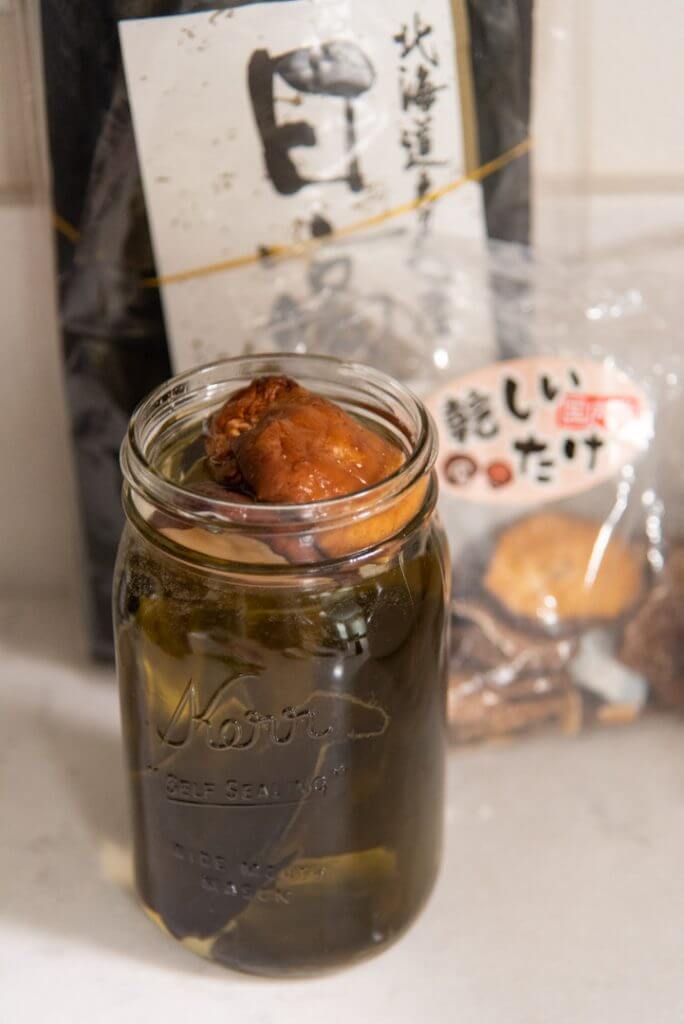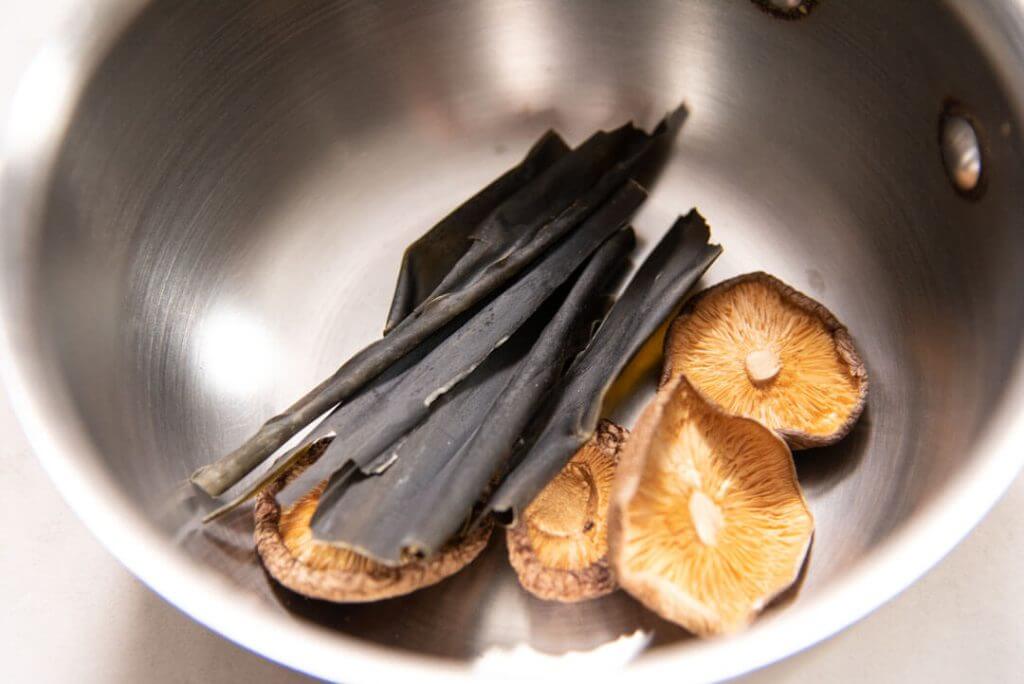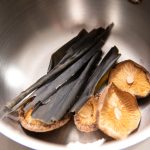Shiitake mushrooms and konbu are arguably some of the most important ingredients in plant based Japanese cuisine. Why? because they can be used in so many different ways. Not only konbu (dried kelp) by itself and not only shiitake (by itself), but also together when they are used to make dashi. In this post and video, i’ll show you two simple ways that you can make it. Chances are you may not know of the second one. Read and watch to learn more.

Shiitake Konbu dashi しいたけ昆布だし
interested in plant based japanese cuisine?
if so, this could be one of the most ingredients used in your japanese cooking
dashi is a multipurpose stock that can be made from a variety of ingredients.
in japanese cuisine, the most commonly used ingredients for dashi are dried shiitake, konbu and katsuobushi.
the katsuobushi, while flavorful and complex, doesn’t need to be used for all types of japanese cooking.
in shojin ryouri for example, when a dish calls for dashi, the dashi used will often be made from dried shiitake mushrooms and or konbu.
in fact, you can use either konbu alone or shiitake mushrooms alone and make konbu dashi or shiitake dashi.
like i mentioned dashi has many different uses and is something you could use almost every day of the week if you wanted to.
that’d be pretty hardcore!

the synergy of konbu and shiitake
is exponential.
especially when it comes to umami and improving the flavor of your foods.
so when you combine the two, the umami compounds of each ingredient work together and can significantly increase the umami power.
much more so than they do individually.
that’s why you’ll see these (dried shiitake and konbu) used in combination with other ingredients like katsuobushi or other dried fish/vegetables.
but now that you know that, the good news is if you’re trying to eat more plant based foods, you dont need katsuobushi to make dashi
and that using these together can drastically increase the power of umami, what will you make next?
i included a few ideas below to get you started.
if they arent enough, you could also search the archives or consider joining the japanese cooking club for more plant based japanese cooking inspiration

what can you make with shiitake konbu dashi?
almost any dish that calls for ‘dashi’ can also use shiitake konbu dashi.
- nimono (japanese simmered foods)
- shirumono (japanese soups) like miso soup
- nabemono (japanese hot pot)
- mentsuyu (noodle soup base)
- dressings (japanese style)
- takikomigohan (seasoned rice)
- ankakedonburi (thickened dashi soy rice bowl)
- ohitashi (soaked vegetables)
- agedashi tofu (fried tofu)
- and many many many more dishes!
note- if you’re used to katsuobushi, it may be noticeable in the dish, so certain dishes lend themselves better to the substitution than others.
a simple bit of advice is, if you’re going to be using soy sauce or other strong flavors like miso, you’ll be less likely to notice. but if you’re making something lightly seasoned like takikomigohan or osuimono (dashi soup) it will be more obvious. so i’d encourage you to experiment and see what flavors you like best, that’s the best way for you to learn!
dried shiitake dashi | japanese dashi recipe 2 ways!
can you use fresh shiitake mushrooms to make dashi?
no unfortunately you can’t.
the reason is the umami is trapped inside the living cells when fresh.
dehydrating them (completely drying them) and rehydrated in water.
this causes the cells to lose their structure and releases all their umami goodness out into the universe.
how to store your shiitake konbu dashi
because there are no preservatives it’s best to use the dashi either the same day or within 1-2 days or it may spoil.
the good thing is that if you make a lot or have leftovers, it freezes well.
i usually store it in glass jars and use within a week or two.

how do you use the leftover shiitake and konbu after making dashi?
in japanese there’s a phrase もったいない ‘mottainai’ or to be wasteful in english.
if you’re going to make dashi, you have the added benefit of being able to reuse the raw ingredients for other foods.
in this case the konbu and shiitake.
once you’ve made dashi with the shiitake and the konbu, they can be called ‘dashigara’ だしがら literally ‘dashiempty ‘.
if you can’t use it right away just freeze them in a freezer ziplock.
i usually make a large batch of tsukudani or shiokonbu once i have a decent amount.
other ways you can recycle these ingredients are in any soups, stews, or simmered foods.
while they may not pack as much flavor as they initially did, prior to making dashi, they’ll still have a good amount of nutrition available.
and chances are if you’re getting decent quality shiitake mushrooms and konbu, you may know that these ingredients aren’t necessarily ‘cheap’
so get your moneys worth and consider saving the dashigara konbu and shiitake for another dish!
want to learn more about plant based japanese cooking?
get on the waitlist for the new plant based japanese cooking mini course.
see you on the inside!
PrintShiitake Konbu dashi しいたけ昆布だし
- Prep Time: 3 minutes
- Cook Time: 15 minutes
- Total Time: 18 minutes
- Yield: 4 cups 1x
- Category: multipurpose
- Cuisine: Japanese
Ingredients
- 10 g square dried konbu (4x5 inches)
- 5 grams dried shiitake mushrooms (3–6 pieces)
- 4 cups of water
Instructions
Mizudashi (水だし cold water method)
- Add the konbu, dried shiitake and water to an airtight container and allow to sit in the refrigerator overnight.
- When the time has passed, strain and use immediately or store in the fridge and use or freeze within 2-3 days.
- Save the konbu and shiitake to reuse for something like tsukudani or add it to your miso soup.
Nidashi (煮だし simmered method)
- Using a medium saucepan, add the konbu, shiitake and water. Let it rest and rehydrate at least 30 minutes.
- After time is up, heat on medium heat and bring the stock to just before a boil. You’ll notice tiny bubbles forming near or around the konbu. This indicates that you’ll soon need to turn the heat down and maintain that state (avoiding a boil). Keep at this level for at least 10 minutes before removing konbu from the pot.
- Continue cooking shiitake mushrooms for another 20-30 minutes at a gentle simmer.
- Strain and use immediately or store in the fridge and use or freeze within 2-3 days.
- Save the konbu and shiitake as above.
Notes
Tips–
- lightly wiping dry konbu with a cloth is optional and in my experience it doesn’t affect the flavor, so I don’t do it. Note that the white powder you see on the konbu is the good stuff (umami). You may lose some of it if you wipe too aggressively.
- Try not to break or cut slits into your konbu as it can hasten release of bitter flavors and slime.
- For the mizudashi method, reuse the konbu a second time and add katsuobushi to make regular dashi. There’s a lot of flavor left in it as the mizudashi method is passive. The same goes for the shiitake, which can be reused in soups or stews.
- Avoid using high heat or cooking for longer than indicated. Overcooking/heating can cause bitter flavors and slime to be released into the broth.
5 tips for dashi(shiitake/konbu)
1.Use the easy method -mizudashi
2.Weigh the ingredients for consistent strength/flavor
3.Freeze extra in glass, use within 2-3 weeks
4.Save ingredients to reuse – dashigara shiitake/konbu (shiitake and konbu that has been used to make dashi still has flavor, umami, and nutrition!)
5.Replace vegetable stock for a lighter base that will highlight the natural flavor of vegetables in your soups, stews and provide more umami







